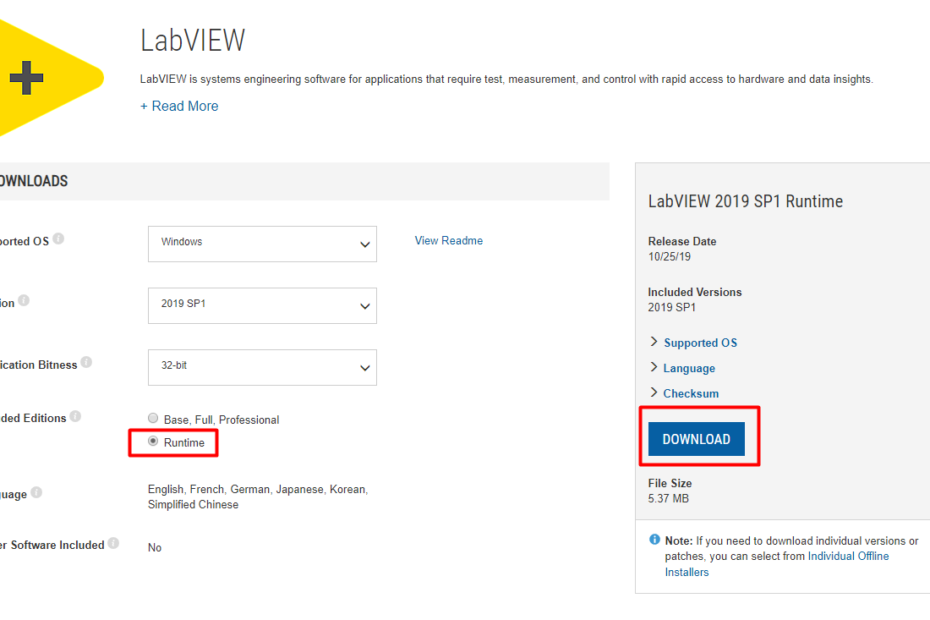If you have ever worked with LabVIEW, you understand its power in creating intricate and powerful applications for various industries. But have you ever wondered, how these applications run seamlessly on different systems? That’s where the LabVIEW Runtime Engine comes into play. In this article, we’ll delve into the depths of LabVIEW Runtime Engine, exploring its features, installation process, integration with LabVIEW applications, and much more.
What is LabVIEW Runtime Engine?
LabVIEW Runtime Engine is a vital component of the LabVIEW ecosystem. It is a free software module developed by National Instruments that allows users to run applications created in LabVIEW without the need for the full LabVIEW development environment.
Importance of LabVIEW Runtime Engine in running LabVIEW applications
Without the Runtime Engine, users would be required to have the complete LabVIEW development environment installed on their systems to run LabVIEW applications. This would not only be cumbersome but also impractical, especially in scenarios where the end-users do not need access to the development environment.
Features
Compatibility with LabVIEW applications
LabVIEW Runtime Engine ensures seamless compatibility with applications developed in LabVIEW. It provides the necessary runtime environment for executing LabVIEW code efficiently.
Lightweight and efficient runtime environment
The Runtime Engine is designed to be lightweight, consuming minimal system resources while providing optimal performance. This ensures that LabVIEW applications run smoothly even on systems with limited hardware capabilities.
Support for various operating systems
LabVIEW Runtime Engine is available for a wide range of operating systems, including Windows, macOS, and Linux. This ensures that LabVIEW applications can be deployed across different platforms without any compatibility issues.
Installation Process
Installing LabVIEW Runtime Engine is a straightforward process:
- Downloading the LabVIEW Runtime Engine: Visit the National Instruments website to download the appropriate version of the Runtime Engine for your operating system.
- Installation steps for different platforms: Follow the on-screen instructions to install the Runtime Engine on your system. The installation wizard will guide you through the process, making it easy and hassle-free.
Integration with LabVIEW Applications
LabVIEW Runtime Engine seamlessly integrates with LabVIEW applications, allowing them to be deployed and run on end-user systems without requiring the full LabVIEW development environment.
How it works with LabVIEW applications
When a LabVIEW application is built, it is compiled into an executable file along with the necessary components of the Runtime Engine. This executable file can then be distributed to end-users, who can run the application using only the Runtime Engine.
Benefits of using the runtime engine for deployment
Using the Runtime Engine for deploying LabVIEW applications offers several benefits:
- Simplified deployment process: End-users can run LabVIEW applications without the need for complex installation procedures.
- Reduced resource consumption: The lightweight nature of the Runtime Engine ensures minimal impact on system resources.
- Enhanced portability: LabVIEW applications can be deployed across different platforms with ease, thanks to the cross-platform support of the Runtime Engine.
Versions and Updates
LabVIEW Runtime Engine is regularly updated to incorporate new features, enhancements, and bug fixes. It is essential to keep the Runtime Engine updated to ensure compatibility with the latest LabVIEW applications and operating system updates.
Overview of different versions
LabVIEW Runtime Engine is available in different versions, each tailored to specific LabVIEW releases and operating system requirements. Users should choose the appropriate version based on their LabVIEW application and system configuration.
Importance of keeping the runtime engine updated
Keeping the Runtime Engine updated ensures compatibility with the latest LabVIEW applications and operating system updates. It also helps in addressing security vulnerabilities and improving performance and stability.
Deployment Considerations
When deploying LabVIEW applications using the Runtime Engine, several considerations need to be taken into account:
Licensing requirements
Some LabVIEW applications may require specific licensing arrangements for deployment using the Runtime Engine. It is essential to understand the licensing requirements and ensure compliance before distributing applications to end-users.
Compatibility with different LabVIEW versions
The compatibility of LabVIEW applications with different versions of the Runtime Engine and LabVIEW development environment should be verified to avoid compatibility issues and ensure optimal performance.
Performance Optimization
Optimizing the performance of LabVIEW applications deployed with the Runtime Engine involves:
- Streamlining code: Writing efficient and optimized LabVIEW code to minimize resource usage.
- Utilizing hardware acceleration: Leveraging hardware acceleration features to enhance application performance.
- Implementing caching mechanisms: Employing caching mechanisms to reduce the overhead of repetitive computations.
Best practices for efficient deployment
Adhering to best practices for deploying LabVIEW applications with the Runtime Engine can help maximize performance and reliability:
- Including only necessary components: Avoiding unnecessary dependencies to keep the deployment package size minimal.
- Testing on target platforms: Testing LabVIEW applications on target platforms to identify and address any compatibility or performance issues.
Security Considerations
Ensuring the security of LabVIEW applications deployed with the Runtime Engine is paramount:
Measures to ensure the security of LabVIEW applications deployed with the runtime engine
- Code obfuscation: Implementing techniques to obfuscate LabVIEW code to protect intellectual property and sensitive algorithms.
- Data encryption: Encrypting sensitive data transmitted or stored by LabVIEW applications to prevent unauthorized access.
- Access control: Implementing access control mechanisms to restrict unauthorized access to LabVIEW applications and resources.
Troubleshooting and Support
Despite the robustness of LabVIEW Runtime Engine, users may encounter issues during deployment or runtime:
Common issues
- Compatibility issues with specific hardware or software configurations.
- Runtime errors or crashes due to application bugs or system issues.
- Licensing or activation issues related to the Runtime Engine.
Resources for troubleshooting and support
National Instruments provides extensive documentation, forums, and technical support channels for users encountering issues with the Runtime Engine. Users can also leverage community forums and online resources for additional assistance.
Use Cases
LabVIEW Runtime Engine finds application across various industries and domains:
Industries and applications is commonly used
- Industrial automation: Controlling and monitoring automated processes in manufacturing plants and factories.
- Test and measurement: Conducting precise measurements and data acquisition in research labs and engineering environments.
- Academic and research: Developing educational and research-oriented applications for universities and research institutions.
Success stories of companies leveraging the runtime engine
- Company A streamlined their manufacturing processes by deploying LabVIEW applications powered by the Runtime Engine, resulting in significant cost savings and improved productivity.
- Company B revolutionized their testing procedures by deploying LabVIEW-based solutions, enabling real-time data acquisition and analysis.
Future Developments
The future of LabVIEW Runtime Engine looks promising, with ongoing developments and advancements:
Potential advancements
- Enhanced compatibility: Further improving compatibility with emerging technologies and platforms.
- Performance optimizations: Introducing optimizations to improve runtime performance and efficiency.
- Security enhancements: Implementing additional security features to address evolving threats and vulnerabilities.
Emerging trends in LabVIEW application deployment
- Edge computing: Leveraging LabVIEW applications at the edge for real-time data processing and analysis.
- IoT integration: Integrating LabVIEW applications with IoT devices for enhanced monitoring and control capabilities.
Comparison with Alternatives
LabVIEW Runtime Engine offers several advantages over alternative deployment options:
Contrasting with other deployment options
- Compared to standalone executables, LabVIEW Runtime Engine offers better portability and compatibility across different platforms.
- Unlike web-based deployment, LabVIEW Runtime Engine provides offline access and better performance for resource-intensive applications.
Advantages and disadvantages of using the runtime engine
- Advantages: Simplified deployment process, reduced resource consumption, enhanced portability.
- Disadvantages: Licensing requirements, potential compatibility issues with specific configurations.
Cost Considerations
Understanding the cost implications of deploying LabVIEW applications with the Runtime Engine is essential:
Pricing models
LabVIEW Runtime Engine is typically available for free, allowing users to distribute LabVIEW applications without additional licensing costs.
Cost-effectiveness compared to other deployment methods
Compared to alternative deployment methods, such as standalone executables or web-based deployment, using the Runtime Engine can be more cost-effective in terms of deployment simplicity and resource efficiency.
User Experience
Feedback from users highlights the positive experience of deploying and running LabVIEW applications with the Runtime Engine:
User testimonials and reviews
- “Deploying LabVIEW applications with the Runtime Engine has been a breeze. Our end-users appreciate the simplicity and efficiency of running our applications without the need for the full development environment.”
- “The lightweight nature of the Runtime Engine ensures smooth performance even on low-end systems. It has significantly improved the accessibility of our LabVIEW-based solutions.”
In conclusion, LabVIEW Runtime Engine plays a pivotal role in deploying and running LabVIEW applications across diverse platforms and industries. Its lightweight and efficient runtime environment, seamless integration with LabVIEW applications, and extensive support make it an indispensable component of the LabVIEW ecosystem. By understanding its features, deployment considerations, and future developments, users can harness the full potential of LRE to create powerful and versatile applications.
FAQs (Frequently Asked Questions)
- Is LabVIEW Runtime Engine compatible with all LabVIEW applications?
- LabVIEW Runtime Engine is compatible with most LabVIEW applications, but compatibility may vary based on the specific features and dependencies of each application.
- Can I distribute LabVIEW applications with the Runtime Engine for commercial use?
- Yes, you can distribute LabVIEW applications with the Runtime Engine for commercial use, but you may need to adhere to certain licensing requirements depending on your use case.
- How often should I update the LabVIEW Runtime Engine?
- It is recommended to keep the LabVIEW Runtime Engine updated regularly to ensure compatibility with the latest LabVIEW applications and operating system updates.
- Are there any security risks associated with deploying LabVIEW applications with the Runtime Engine?
- While LabVIEW Runtime Engine itself is secure, it’s essential to follow best practices for securing your LabVIEW applications, such as implementing code obfuscation and data encryption.
- Where can I find additional support and resources for troubleshooting LabVIEW Runtime Engine issues?
- National Instruments provides extensive documentation, forums, and technical support channels for users encountering issues with the Runtime Engine. Additionally, community forums and online resources can be valuable sources of assistance.

